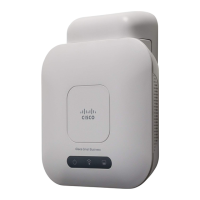ACL
ACL Rule
Cisco WAP571/E Administration Guide 137
9
• Destination Port—Includes a destination port in the match condition for the
rule. The destination port is identified in the datagram header.
- Select From List—Choose the keyword associated with the destination
port to match: ftp, ftpdata, http, smtp, snmp, telnet, tftp, www. Each of
these keywords translates into its equivalent port number.
- Match to Port—Enter the IANA port number to match to the destination
port identified in the datagram header. The port range is from 0 to 65535
and includes three different types of ports:
0 to 1023-Well-Known Ports
1024 to 49151-Registered Ports
49152 to 65535-Dynamic and/or Private Ports
- Mask—Enter the port mask. The mask determines which bits are used
and which bits are ignored. Only the hexadecimal digit (0 - 0xFFFF) is
allowed. 0 means the bit matters and 1 means that we should ignore this
bit.
• Service Type—Matches the packets based on specific service type.
- IP DSCP Select From List—Matches the packets based on their DSCP
Assured Forwarding (AS), Class of Service (CS), or Expedited
Forwarding (EF) values.
- IP DSCP Match to Value—Matches the packets based on a custom
DSCP value. If selected, enter an value from 0 to 63 in this field.
- IP Precedence—Matches the packets based on their IP precedence
value. If selected, enter an IP Precedence value from 0 to 7.
- IP ToS Bits—Specifies a value to use the packet's ToS bits in the IP
header as match criteria.
The IP ToS field in a packet is defined as all eight bits of the Service
Type octet in the IP header. The IP ToS Bits value is a two-digit
hexadecimal number from 00 to ff. The high-order three bits represent
the IP precedence value. The high-order six bits represent the IP
Differentiated Services Code Point (DSCP) value.

